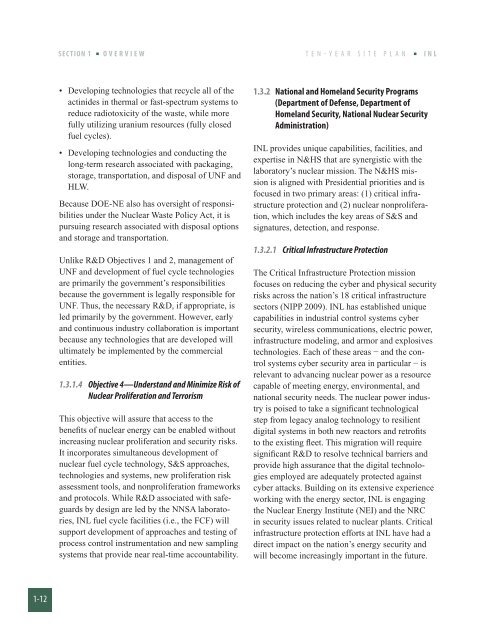2013-2022 TEN-YEAR SITE PLAN - Idaho National Laboratory
2013-2022 TEN-YEAR SITE PLAN - Idaho National Laboratory
2013-2022 TEN-YEAR SITE PLAN - Idaho National Laboratory
Create successful ePaper yourself
Turn your PDF publications into a flip-book with our unique Google optimized e-Paper software.
1-12<br />
SECTION 1 OVERVIEW<br />
• Developing technologies that recycle all of the<br />
actinides in thermal or fast-spectrum systems to<br />
reduce radiotoxicity of the waste, while more<br />
fully utilizing uranium resources (fully closed<br />
fuel cycles).<br />
• Developing technologies and conducting the<br />
long-term research associated with packaging,<br />
storage, transportation, and disposal of UNF and<br />
HLW.<br />
Because DOE-NE also has oversight of responsibilities<br />
under the Nuclear Waste Policy Act, it is<br />
pursuing research associated with disposal options<br />
and storage and transportation.<br />
Unlike R&D Objectives 1 and 2, management of<br />
UNF and development of fuel cycle technologies<br />
are primarily the government’s responsibilities<br />
because the government is legally responsible for<br />
UNF. Thus, the necessary R&D, if appropriate, is<br />
led primarily by the government. However, early<br />
and continuous industry collaboration is important<br />
because any technologies that are developed will<br />
ultimately be implemented by the commercial<br />
entities.<br />
1.3.1.4<br />
Objective 4—Understand and Minimize Risk of<br />
Nuclear Proliferation and Terrorism<br />
This objective will assure that access to the<br />
benefits of nuclear energy can be enabled without<br />
increasing nuclear proliferation and security risks.<br />
It incorporates simultaneous development of<br />
nuclear fuel cycle technology, S&S approaches,<br />
technologies and systems, new proliferation risk<br />
assessment tools, and nonproliferation frameworks<br />
and protocols. While R&D associated with safeguards<br />
by design are led by the NNSA laboratories,<br />
INL fuel cycle facilities (i.e., the FCF) will<br />
support development of approaches and testing of<br />
process control instrumentation and new sampling<br />
systems that provide near real-time accountability.<br />
1.3.2<br />
T E N - Y E A R S I T E P L A N INL<br />
<strong>National</strong> and Homeland Security Programs<br />
(Department of Defense, Department of<br />
Homeland Security, <strong>National</strong> Nuclear Security<br />
Administration)<br />
INL provides unique capabilities, facilities, and<br />
expertise in N&HS that are synergistic with the<br />
laboratory’s nuclear mission. The N&HS mission<br />
is aligned with Presidential priorities and is<br />
focused in two primary areas: (1) critical infrastructure<br />
protection and (2) nuclear nonproliferation,<br />
which includes the key areas of S&S and<br />
signatures, detection, and response.<br />
1.3.2.1 Critical Infrastructure Protection<br />
The Critical Infrastructure Protection mission<br />
focuses on reducing the cyber and physical security<br />
risks across the nation’s 18 critical infrastructure<br />
sectors (NIPP 2009). INL has established unique<br />
capabilities in industrial control systems cyber<br />
security, wireless communications, electric power,<br />
infrastructure modeling, and armor and explosives<br />
technologies. Each of these areas − and the control<br />
systems cyber security area in particular − is<br />
relevant to advancing nuclear power as a resource<br />
capable of meeting energy, environmental, and<br />
national security needs. The nuclear power industry<br />
is poised to take a significant technological<br />
step from legacy analog technology to resilient<br />
digital systems in both new reactors and retrofits<br />
to the existing fleet. This migration will require<br />
significant R&D to resolve technical barriers and<br />
provide high assurance that the digital technologies<br />
employed are adequately protected against<br />
cyber attacks. Building on its extensive experience<br />
working with the energy sector, INL is engaging<br />
the Nuclear Energy Institute (NEI) and the NRC<br />
in security issues related to nuclear plants. Critical<br />
infrastructure protection efforts at INL have had a<br />
direct impact on the nation’s energy security and<br />
will become increasingly important in the future.

















